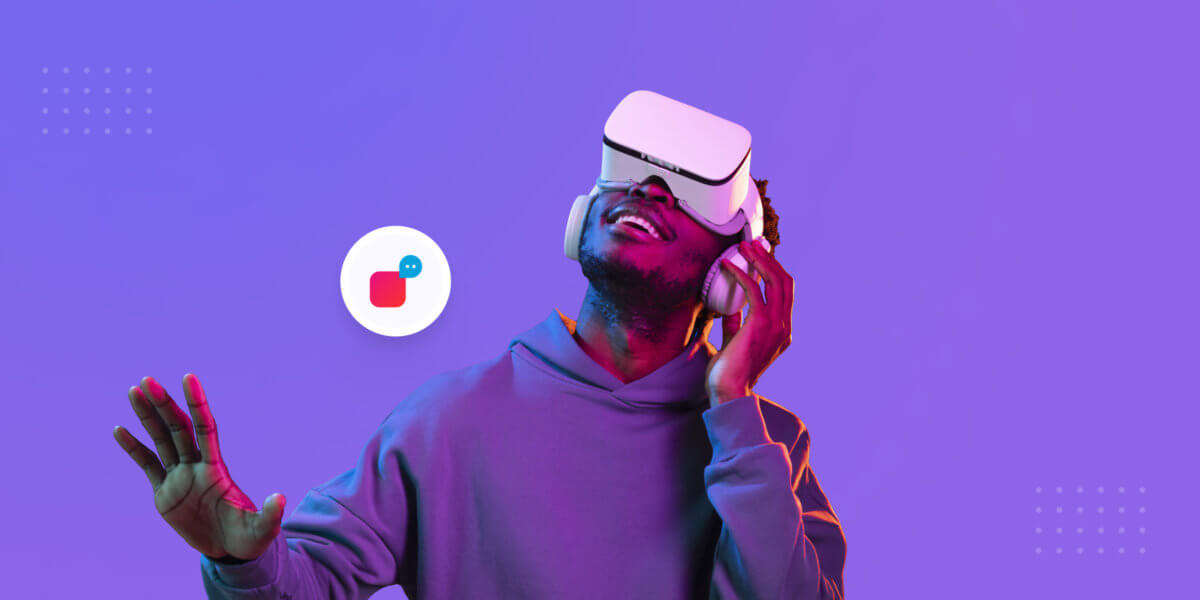What is Conversational Marketing and How to Use it to Grow Business?

What is Conversational Marketing and How to Use it to Grow Business?
Over the past few years and months, you’ve probably heard a lot about automation. From Tesla’s attempt at automating an entire factory to semi-autonomous surgical robots, to Amazon’s no-humans-required grocery store. All the biggest companies with the biggest bank accounts are investing in automation; of course, they would, it’s the way forward.
But what about you? How can your company automate its processes?
What is Conversational Marketing?

Conversational Marketing is defined as a one-on-one feedback-focused communication between companies and customers, across multiple channels, to drive engagement, shorten the sales cycle, develop customer loyalty, grow the customer base, and, ultimately, increase revenue, by way of creating a more human buying experience.
Conversational marketing isn’t limited to live chat, it’s an all-encompassing campaign. From emails and customer support to customer loyalty and success programs, being time sensitive and personal will never run out of fashion. Instead of blasting out that generic copy and picture, conversational marketing starts anew by answering people’s questions, listening to their feedback, and then uncovering new ways to help them.
The people have spoken. Research has shown that only 43% of people answer cold calls, the average email open rate is about 20%, and the average landing page conversion rate is just 2.35%. Traditional marketing efforts are not just bad for the people, they’re also bad for business.
But more importantly, people’s representatives have spoken too. GDPR was the death of data hoarding and email spam, marketers will now need to justify why they are holding each piece of personal information and the legal basis on which it’s being used for marketing. This means an end to third-party lead generation companies and list providers, no pre-ticked boxes along with a guillotine to legal cop-outs like assumed consent and opt-ins.

The internet is the most potent two-way communication interface in the history of humanity, so why are you using it just to blast out emails?
It’s time to find a new slant.
Or, the oldest pillar in the business.
Suggested Reading: Chatbot Websites, And The Future Of Website Metrics
Even since before humans could speak each other’s languages, they conversated.
Vasco Da Gama and Christopher Colombus are widely regarded as the pioneers of the first international trade boom, and ever since then, conversational commerce has flourished. Back in the good old days, both humans and business alike traded by having face-to-face conversations. And when speaking directly to the customer was no longer an option, businesses used pigeons to exchange letters, they coded and decoded in morse, traded telegraphs, sent the other party faxes, left each other voicemails and flooded email inboxes; all in the hopes of returning to personalisation and comfort of that first human interaction.

Even in the age of the all-encompassing internet, you still see conversations in the world of marketing and sales today. It’s in that corner store your mother visits, where she buys that ointment for her bad back because it’s what the shopkeeper recommends. It’s in your local flower shop, where the florist keeps those hydrangeas ready so you can pick them up for your sisters’ graduation. It’s in millions of small businesses across the world where one-on-one, human conversations drive marketing and sales.
In the modern world, we’ve changed what we consider acceptable response times. It doesn’t take two weeks to get the word out on a great house party anymore, it takes two minutes and the right Whatsapp group. Families live closer together through the digital web, friends are around more and teachers answer your questions faster.
So why don’t businesses?
Most companies can’t be blamed for not being more adventurous.
Marketing is like poker, it’s a zero-sum game. For every winner, there’s a loser.

Every product that is bought from your company, is a product that your customer isn’t buying from the competition. This is why bad habits tend to stick in the world of marketing and sales; if it makes money for one person, everyone follows suit (read as email blasts). Behavioral Economics calls it “risk aversion”; the phenomenon described as having, “losses loom larger than gains.”
The pain of potentially losing is greater than the pleasure of winning, so companies are obliged to play it safe and be repetitive. It sucks because most marketing and sales solutions today were designed to automate business processes, and not to offer the intelligence needed to make informed decisions.
Conversational marketing has been around since the dawn of time, so why the renewed interest?
It’s because we now have the technology not to just have these one-to-one conversations, but to be able to have them at scale. That tied to consumers who value personalization and accessible interfaces mean that conversational marketing and sales have become more relevant than ever before.
What are the Advantages of Conversational Marketing?
Time never stops never stopping

Your business doesn’t just run business hours. You’ll have prospects who visit your website at any hour that pleases them, customers who will have questions and queries only once they’re home and businesses who will want to discuss deals in the dead of the night. Instead of having them fill out static lead and contact forms (1%), move from simple customer engagement to a more fulfilling customer delight. Using conversational marketing and A.I. powered bots, you can generate leads, answer queries, and book meetings, 24/7, 365 days a year so you can interact with your customers in real time.
Another important face of conversational marketing is that they don’t happen solely in a single sitting, so your conversations need to be able to be carried over. Regardless of whether it’s in real-time, after finishing their meeting, or later that night when they have a spare moment, your bot should be able to pick up where they left off with your customer and deliver.
A customer doesn’t care if you’re talking with 10, 100, or 1,000 other people — they only care about the issue they need to be solved.
Can we build it at scale? Yes, we can!


All marketing campaigns are inevitably planned with a singular aim: Increase Word of Mouth marketing, so your customers do the advertising for you.
92% of consumers trust recommendations from their friends or family more than any other form of marketing, and a significant part of that statistic stems from having built a bond with your family and friends. Companies know that face-to-face conversations are the best way to build these bonds, but this isn’t scalable.
Scaling conversations have never been easy, regardless of whether it’s in customer support, marketing or sales. In order to have 100 one-to-one conversations with leads or customers simultaneously, you’d need to have 100 employees; or a lot of disgruntled people on hold.
When you stop pitching and start listening to what the other person has to say, it makes conversations more natural and opens up opportunities to cross-sell, encourage sharing, solicit input, as you flow seamlessly between commerce and support.
With a live chat/bot function assisting your conversational marketing functions, you can have one on one conversations with all your customers, or allow the bot to talk to them just like you would.
Suggested Reading: What is Conversational Support and How to Automate it?
Engagement

Let’s be honest, we’ve reached a point in the technological revolution where you no longer check your email inbox because you want to, but because you have to.
While a handful of things like sending contracts might not be socially acceptable, there’s little to nothing you couldn’t do with your phone. And consumers agree. According to TechCrunch, consumers spend 5 hours per day on their phones. And if you’re wondering what those dang kids are spending so much time on, you can go through Facebook’s February earnings, which claims that WhatsApp and Facebook Messenger and Instagram had 1.5 billion and 1.3 billion and 1.1 billion monthly active users, respectively.
The present is mobile, if you’re not on the same platform as your customers, they’re not going to be there with you. Using conversational marketing you can be with your customers when they want, where they want, and how they want – giving your audience control over their own support, sales queries or marketing efforts.
Conversational Marketing is not just a matter of convenience for the people who use it, it’s also a great way to present your company culture. Using specific content tools like copywriting, games, emojis, videos, and gifs you can share with your customers, fellow companies and clients what your brand personality is. As customers engage with the bot, they learn not only about your company but your company’s product offerings.
Made by you, for people like you
Context is one of the most important facets of a holistic conversation. It’s why politicians often speak in sound bites, since what they say is reported in sound bites. By eliminating context, they keep their answers consistent and clear of scrutiny.
Context is what builds bonds, it’s what makes inside jokes and great storytellers. With conversational marketing, every interaction you have with a prospect, customer or business is built on a round mound of context, which makes shooting your initial shot or grabbing sales rebounds a better service-side experience.
Using conversational marketing, you can create simple delights like custom-made conversation starters depending on what page of your website your prospect is on, to data enriched lead qualification. By getting to the heart of the issue seamlessly since you don’t have to waste time collating information you already have access to, you can create more personalized and contextual conversations.
Suggested Reading: Conversational AI is Enhancing the Current Support Experience
Data
Traditional data collected from traditional marketing suffers from a traditional problem.
By virtue of being data-centric, the current incentives for marketing are to collect more data, not make more fulfilling experiences for customers. Marketing as it stands today is more focused on being data-driven, instead of being customer-driven.
We’re ready to burden our customers with a stream of endless emails, contact forms and calls just so we can put their names in a spreadsheet which just more begets more emails, contact forms and calls. What’s the point of knowing someone’s name if you don’t know what they like about your product?
And while you could make your nine-question contact form even longer to accommodate that, but it will never give you the same depth and understanding you could derive from a full-fledged one-on-one conversation. Use the power of artificial intelligence to collect information as a human being instead of simply employing a static tool.
Analyze engagement, retention, funnel bottlenecks, customer pain points and other key metrics that are ignored by traditional methods.
How Can You Use It to Grow Your Business?

We understand that all of this might seem a bit daunting. What sounds great on paper, tends to be more difficult to implement in real life. Conversational automation has several nuances that require a step by step breakdown.
All of this is simplified and achieved by a seven-step process that will help you build a conversational marketing framework for your company and break down the walls between support, sales, and marketing.
#1 – Look at existing data
The first step to a successful conversational marketing framework is understanding where you stand. For this, identify your existing analytics, like your email flows, your chat logs, chat dump, ticket handling, queries, and closing.
While conversational marketing is the throwaway phrase that companies use, it is just one piece of the puzzle. Conversations need to happen across all your offerings, sales, support, marketing; everything. All of these touchpoints are the building blocks for what you bot will look like, what it will say and what it will handle.
#2 – What is your target group
Once you’ve identified and dissected your metrics, you can now turn to your customers. If you have a large, unfragmented audience, you need to make sure your bot works for every segment the same way, without alienating anyone. This means multi-language support, no endemic downtime, and a user-friendly, nondiscriminatory interface.
Target specific audiences and position your conversational platform in such a way that it appeals to as many potential customers as it can, regardless of age, income, gender, location, lifestyle, usage, and occupation. Each segment should have predetermined goals for their interaction with your live chat or bot, that you will use to design the bots flow.
#3 – Define your features
Using step #1 and #2, define the first set of offerings that you want to bring under the conversational marketing umbrella. This could mean scrapping out all your contact forms and email subscription buttons if you’re feeling bold, or running them side by side with a live chat or bot.
The number and scope of features should not seek to replace your customer support entirely, but to augment them to function more efficiently. If with time, you think more can be achieved by a complete automation of your conversational functions, then you can put your live chat buttons everywhere on your website to maximize conversations.
#4 – Personality
With this, you will also have to define and distinguish your brands’ persona. Your company culture and brand persona will vary depending on how various conversational characteristics, such as.
> Sentences, words, emoticons.
> The length of your answers.
> The use of pictures, videos and gifs.
> The use of forms and selection buttons.
> When to trigger a proactive dialogue.
Bots can be playful and cute, or professional and to the point. For a younger audience, you can implement a friendly faced bot, using emojis and gifs that aid your conversation to make it seem more human. If you are a B2B business, you can use short, cohesive sentences with graphs and numbers.
#5 – The copywriting
Your conversational marketing is only as strong as the words you use to drive it home. Your live chat or bot is built solely on the words you train it to use; its text is the heart of your product offering. To this end, we urge companies to use professional help to write conversations.
The crux of this process is divided into four steps
- Writing scenarios
- Prioritising scenarios
- Delivering dialogues
- Optimising dialogues.
Sit down with your copywriters and designers and create a hypothesis of what makes a good dialogue – based on your targets.
#6 – Measure, optimize, improve
Once you’ve finished building your conversational marketing framework, you are now ready to run it live. We recommend running it with a test group first, so you can measure , optimize and improve how your bot functions before you launch it to your entire customer base.
You can run A/B tests, to identify if certain words trigger certain purchase decisions better than other, you can tweak dialogue triggers, to see if a customer is more likely to talk to the bot in ten seconds, or five. Identify roadblocks where customers stop interacting with your bot, and set in motion easers to rectify them. Everything from the bots tone of voice, the complexity of the sentence, the gif that takes too long to load on a slow internet connection, whatever your hypothesis: run an isolated ab-test.
#7 – Rinse and repeat
Repeating and understanding that there is always room for improvement is a key parameter. As your bot provider launches new features like updated dashboards, Machine Learning powered FAQ automation, Drip Campaign support, you can constantly improve its performance and find more value to unlock. The real work is in running experiments and always working to get closer to your end goal: to help customers get jobs done via engaging and helpful dialogue.
The end goal for all conversational marketing is simple; Make business personal again.
Suggested Reading: Conversational Marketing Case Studies






